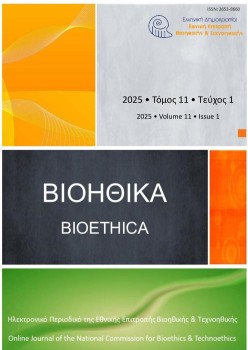Pediatric Deep Brain Stimulation for Therapy and Neuroenhancement: Ethical, Clinical and Legal Dimensions

Abstract
Deep Brain Stimulation (DBS) is traditionally applied in adults for the therapy of certain neurological and psychiatric disorders. Except for adults, it can also be implemented in children, but its applications in pediatrics are limited. A groundbreaking scenario regarding the future of DBS is its potential use beyond the restoration of human health, in the field of neuroenhancement. However, the new applications of DBS present serious ethical, clinical, and legal concerns, which are examined in this paper.
In the beginning, the applications of pediatric DBS are presented, along with the method’s potential short- and long-term effects. Subsequently, the concept of “neuroenhancement”, contrasted with “therapy”, and the potential role of pediatric DBS in this domain are analyzed. Moving on to the ethical considerations of pediatric DBS, a wide range of topics are covered, involving safety issues, authenticity, decision-making, and social concerns. In the section on clinical dimensions, the importance of conducting relevant clinical trials as well as their challenges are elucidated. Afterward, as the legal framework of DBS devices is examined, regulations both for medical and non-medical devices are provided, depending on the specific DBS application. These discussions serve as a preparation for the proposal of recommendations, from an ethical, clinical, and legal perspective.
The overall purpose of this paper is to provide pathways for the alignment of scientific advancement with the welfare of children.
Article Details
- How to Cite
-
Minagia, M. (2025). Pediatric Deep Brain Stimulation for Therapy and Neuroenhancement: Ethical, Clinical and Legal Dimensions. Bioethica, 11(1), 36–50. https://doi.org/10.12681/bioeth.40930
- Section
- Reviews

This work is licensed under a Creative Commons Attribution 4.0 International License.
Authors who publish with this journal agree to the following terms:
- Authors retain copyright and grant the journal right of first publication with the work simultaneously licensed under a Creative Commons Attribution CC BY 4.0 License, which allows for immediate free access to the work and permits any user to read, download, copy, distribute, print, search, or link to the full texts of articles, crawl them for indexing, pass them as data to software, or use them for any other lawful purpose. Appropriate credit must be given by citing the author(s) and the original publication in this journal.
- Authors are able to enter into separate, additional contractual arrangements for the non-exclusive distribution of the journal's published version of the work (e.g. post it to an institutional repository or publish it in a book), with an acknowledgement of its initial publication in this journal.
We encourage authors to deposit their articles, as well as data underlying the publications, in institutional and/or other appropriate subject repositories.
Bioethica permits and encourages authors to archive the final publication pdf in institutional (e.g. the repository of the National Hellenic Research Foundation) or other appropriate subject repositories (e.g. SSOAR repository for social sciences), in compliance with institutional and/or funder open access policies, after publication in the BIOETHICA. Authors must provide bibliographic details that credit publication in the journal, as well as related funding details (when applicable).
Lists of institutional and other subject-based academic open access repositories can be found listed by country at the registry http://opendoar.org/countrylist.php
If your institution does not possess a repository you may deposit a copy of your paper at no cost with www.zenodo.org , the repository supported for open access research in the EU by the European Commission, through the project OpenAIRE (www.openaire.eu )


